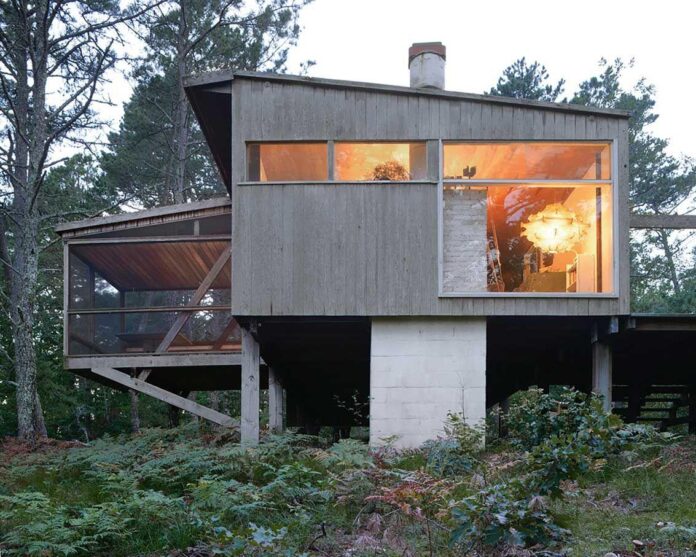In the history of famous artists and writers on Cape Cod in Massachusetts, Provincetown gets most of the glory—with Jackson Pollock, Helen Frankenthaler, Eugene O’Neill and Mary Oliver all having spent time there.
But, a dozen miles down the cape, in the middle of the woods near the town of Wellfleet, around 100 summer houses designed by and for Modernist architects hide among the trees. Marcel Breuer (the architect of New York’s Breuer Building—formerly home to the Whitney Museum of American Art—and designer of the now-ubiquitous Cesca Chair) built a few of these, one for his own family’s use.
Adjacent to the house’s driveway, under a stone slab made by the sculptor Masayuki Nagare, the ashes of Breuer and his second wife, Connie, are buried. The couple’s photographer son, Tamas, is now selling the house, and Peter McMahon, the founder of the Cape Cod Modern House Trust (CCMHT), is in the process of raising around $2m (from both public sources and private donations) to buy it and turn it into a residency for artists, architects and scholars.
Breuer started building his Wellfleet summer home in 1948, a few years after he visited his friend and fellow architect Serge Chermayeff. The trip inspired him to buy a plot of land across the road. Breuer designed his house on stilts to look like it was floating in the woods, with a porch overlooking three ponds, “like a camera on a tripod”, he wrote.
Breuer moved to Massachusetts from Europe in 1937 to teach architecture at Harvard University at the invitation of his mentor, the Bauhaus founder Walter Gropius. There, he “discovered something in the American tradition and everyday life and reinterpreted it”, says the Breuer expert Barry Bergdoll, a professor at Columbia University, a Pritzker Architecture Prize jury member and a former chief curator of architecture at the Museum of Modern Art in New York.
Inspired by the screened-in porches he saw throughout New England, Breuer created a version of his own as a means of opening up his summer home to the surrounding landscape, so that, even inside its walls, one feels “not so much in a room, but suspended outside”, Bergdoll says. “The house reflects his architectural inventiveness,” he says. “It’s a brilliant building and a prototype of Breuer’s vision of how he could marry the ethos of the Bauhaus with the traditions of the American summer cottage. It’s a type he repeated for a number of his friends, forming an informal colony in the woods of Wellfleet.”
Illustrious guests who favoured nudism
Breuer and his family would spend many summers at their Wellfleet house, often accompanied by guests such as the architects Eero Saarinen and Florence Knoll and the artists Alexander Calder and Saul Steinberg. The Breuers and their friends and fellow architects, artists and writers who lived and summered in the area would often gather at the house for cocktail parties, discussions and swims in the nearby ponds. “It was a close-knit group of artists and intellectuals who loved seclusion,” Bergdoll says. “And they loved nude sunbathing—they saw nudism as nature worship.” Their kids played together in an atmosphere that was “more extended compound than individual houses”, he says.
“These were vacation houses, but also places for making, with studios attached, and informal academic seminars,” says McMahon, an architect who grew up in a Modernist Wellfleet house himself—one of around 50 in the area designed by Charles Zehnder. “They were painters, writers and architects, having political arguments and working. It was a rich cultural soup.” Through McMahon’s work with the CCMHT, which he founded in 2007, he has sought to bring that cooperative artistic spirit back to the area. He has already saved and restored four Modernist houses, which now host residencies, programmes with the local high school and university architecture departments. Visitors of all kinds are also able to rent the houses for a week at a time and experience them from within. (“It’s hard to understand a house unless you actually sleep there,” McMahon says.)
McMahon—who is also a carpenter and works on the CCMHT houses himself, including building period-appropriate furniture for their interiors when necessary—has a particular fondness for Breuer, whom he calls his “design mentor”. He is currently working on getting Breuer’s Wellfleet house listed on the National Register of Historic Places, which could save it from anyone seeking to demolish the weathered building in the future. “The land is worth so much more than the house,” he says. (The sudden razing of Breuer’s Geller House on Long Island last year—to make room for a tennis court—is a constant reminder of the vulnerability of these architectural landmarks.) McMahon is particularly excited about the fact that the house remains intact and largely as it was when Breuer died in 1981. “It’s a treasure trove,” he says, adding that Breuer made all its furniture, creating a veritable time capsule of design.
The house also contains a wealth of books and works of art, with many items given to the Breuers by friends and neighbours like Calder, Paul Klee and Josef Albers. McMahon calls the collection “a history of Breuer’s life”, and he is enthused about scholars using the 200 books on the shelves, many inscribed to the Breuer family and some even written in Wellfleet, as primary sources in their research.

Breuer with his daughter, Cesca, and a family friend on the porch of the house
Photo: Tamas Breuer
“McMahon truly understands these houses,” Bergdoll says, calling Breuer’s Wellfleet house “magical”. It is a true example of the Bauhaus pursuit of Gesamtkunstwerk—from its unique tables, couches and hand-woven rugs to how the structure itself levitates among the pines. “Breuer very gently built a house that nestles into the landscape and fits among the existing trees, and its lessons go beyond the year of its construction,” Bergdoll says. “It’s an example of the architect reinventing tradition while responsibly building into the landscape.”

























